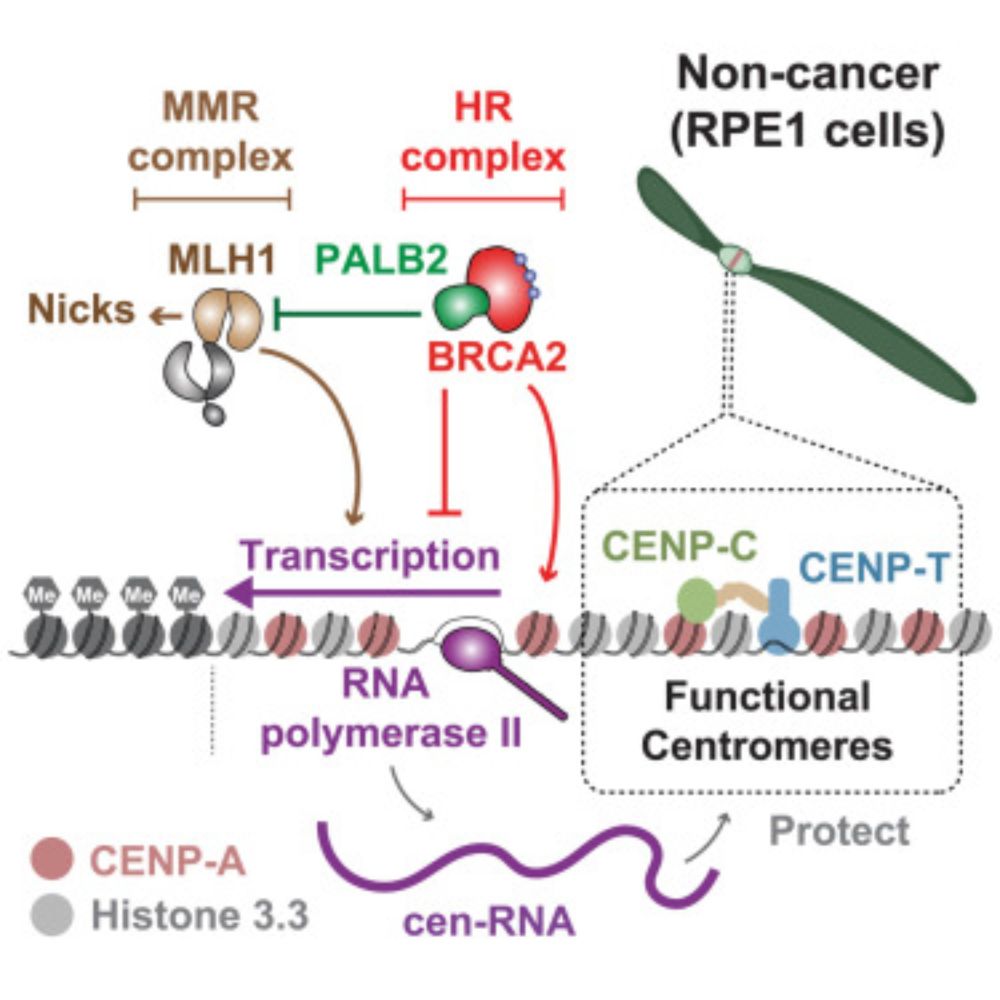YouTube video by Stowers Institute for Medical Research
How Stowers Scientists Found the DNA Site Where Robertsonian Chromosomes Fuse
🚂 The T2T train keeps rolling: "The formation and propagation of human Robertsonian chromosomes" with Gerton and Garrison labs is out! What's a Robertsonian chromosome? Let Jen tell you herself in this great video, or read our paper: [1/3]
📺 youtu.be/JmlY5omxQVc
📄 www.nature.com/articles/s41...
24.09.2025 18:48 — 👍 42 🔁 28 💬 4 📌 1
LinkedIn
This link will take you to a page that’s not on LinkedIn
I am delighted to announce that I am starting my lab next month in @oncology.ox.ac.uk @ox.ac.uk It is such a privilege to be a part of this storied institution!
Also, we are hiring - if chromosomal instability and cancer biology excite you, come join the fun!
Job Specification: lnkd.in/e8-3hyfr
19.08.2025 15:42 — 👍 17 🔁 7 💬 2 📌 0
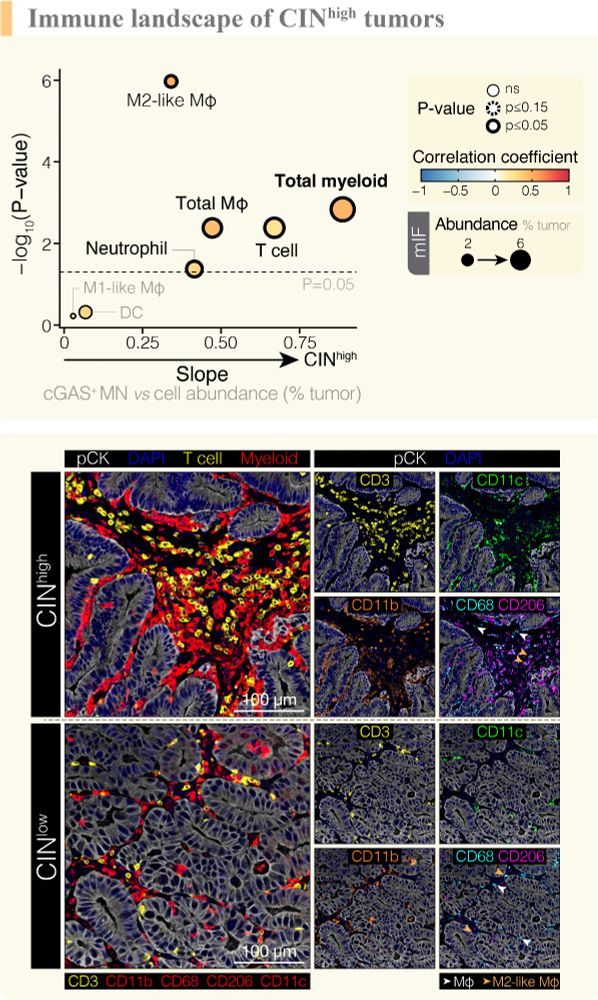
Image shows cell types which correlate with increasing chromosomal instability (myeloid populations dominate) and representative images of inflamed, CINhigh tumor and a CINlow tumor
Using snRNA-sequencing (Izar lab @columbiauniversity.bsky.social) with matched multiplex immunophenotypic profiling (@jleslie1.bsky.social) we found tumor cell-intrinsic innate immune activation and intratumoral myeloid infiltration as phenotypic consequences of ongoing micronucleation in EAC. 7/11
12.05.2025 12:08 — 👍 1 🔁 1 💬 1 📌 0
Wei-ting Lu presents data from the TRACERx lung cancer study on FAT1 alterations and chromosomal instability.
#AACR2025 | @weitinglu.bsky.social | @crick.ac.uk
27.04.2025 15:33 — 👍 2 🔁 1 💬 1 📌 0
I got an idea to make you feel *worse* 🙃🙃-- read Michael Lewis's the fifth risk.
30.01.2025 18:14 — 👍 1 🔁 0 💬 0 📌 0
Homepage - Confocal NL - Designed to respect your cells
Discover the confocal systems that enable you to perform deep and fast live cell imaging, beyond the diffraction limit using only nanowatts of laser power.
We are fortunate to get a trial of the NL5+ confocal system from confocal.nl which is a total gamechanger. @crick.ac.uk @calm-stp.bsky.social just got a NL5+ system after the trial -- can't wait to have more fun with it♥️!! 4/4
17.01.2025 15:17 — 👍 2 🔁 0 💬 0 📌 0
The biggest nemesis of live microscopy is light toxicity. The success rate for mitotic imaging is painfully low because one has to balance resolution vs cell death – either you have a blurry movie or a high-resolution movie showing a dead cell. 3/4
17.01.2025 15:17 — 👍 0 🔁 0 💬 1 📌 0
The cover is designed by Jeroen at Phsopho Animation,
who converted a mitotis time-lapse movie into some awesome cover art. One can see that chromosomes (white) align and then pulled apart by tubulin (red) as the cell divides, showing lagging chromosomes and chromosomal bridges. 2/4
17.01.2025 15:17 — 👍 0 🔁 0 💬 1 📌 0
We’re thrilled to see our research has been highlighted as the cover of NCB this month 🎉 🎉. We are honoured to share this issue with thought-provoking articles investigating multiple aspects of chromosomal instability and mitosis @dfachinetti.bsky.social
@thecesarelab.bsky.social 🧵 1/4
17.01.2025 15:17 — 👍 7 🔁 1 💬 1 📌 0
Finally, a huge thank you to all our funders without which our work would not be possible @crick.ac.uk, Genomics England, @cancerresearchuk.org, @uclh.bsky.social @bcrfcure.bsky.social, Danish Cancer Society, UCL Cancer Institute and @cruk-cityoflondon.bsky.social. 13/14
03.01.2025 11:22 — 👍 2 🔁 1 💬 1 📌 0
We thank all our collaborators @mcclellandlab.bsky.social @taponlab.bsky.social @kfugger.bsky.social @nicky Mcgranahan, Nicholas Birbak, Kevin Litchfield and Mariam Jamal-Hanjani. Thank you to the patients and their families, without which we would not be able to start this project. 12/14
03.01.2025 11:22 — 👍 1 🔁 0 💬 2 📌 0
This would not be possible w/o the bioinformatics input of @jrmblack.bsky.social @oriolpich.bsky.social Chris Bailey @ruizc.bsky.social, Paco Gimeno-Valiente, Ieva Usaite, Kerstin Thol, Maise Al Bakir & Dhruva Biswas who are dedicated to integrating real-life data with experimental results. 11/14
03.01.2025 11:22 — 👍 1 🔁 0 💬 1 📌 0
This work is co-led by @weitinglu.bsky.social and @nnennayakanu.bsky.social lab, with significant input from our long-term collaborator Jiri Bartek . @panoszalmas.bsky.social and high throughput screening core @crick.ac.uk were instrumental in starting this project. 10/14
03.01.2025 11:22 — 👍 0 🔁 0 💬 1 📌 0

Now, which of the FAT1 KO phenotypes are due to YAP1 localization? By depleting YAP1 in FAT1 KO cells, we could fully rescue the cytokinesis failure in FAT1 KO. cells, suggesting this is YAP1 dependent. However, the ⏫mitotic error rate was not dependent on YAP1 dysregulation 9/14
03.01.2025 11:22 — 👍 0 🔁 0 💬 1 📌 0

How does FAT1 loss lead to its phenotype? We noticed that similar to another key member of the Hippo🦛 pathway LATS1, FAT1 depletion enhances YAP1 nuclear signal. Perhaps LATS1/2 loss contribute to the DDR defects and the phenotypes might be somehow dependent on YAP1? 8/14
03.01.2025 11:22 — 👍 0 🔁 0 💬 1 📌 0
How does FAT1 loss cause WGD? Using the FUCCI system in RPE1 cells (thanks to John Diffley lab @crick.ac.uk ) we could track the fidelity of cell division in real-time. The cell without FAT1 failed cytokinesis, could not finish mitosis and remained as 1 daughter cell with 2x the genome content 7/14
03.01.2025 11:22 — 👍 1 🔁 0 💬 1 📌 0
We also used live cell imaging to quantify mitotic errors. 6/14
03.01.2025 11:22 — 👍 0 🔁 0 💬 1 📌 0
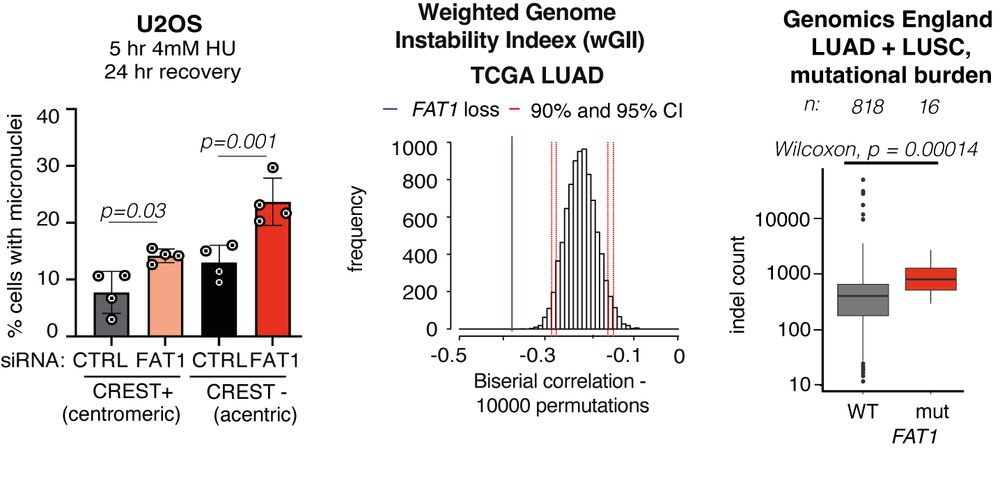
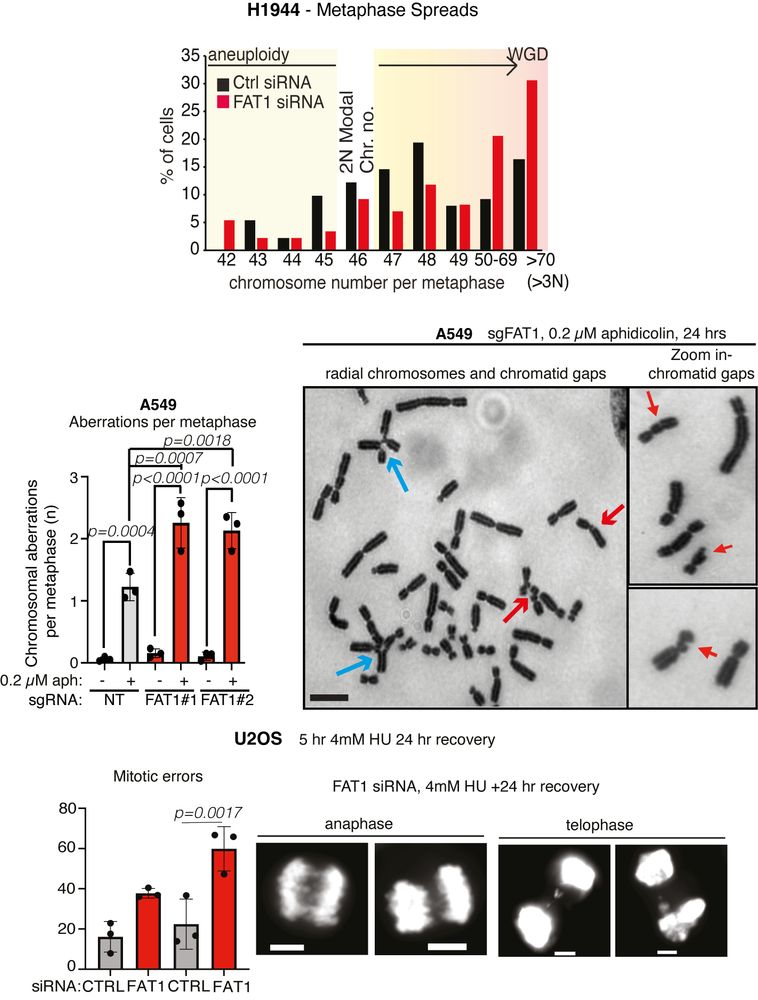
Focusing on CIN, FAT1 loss increased micronuclei formation. FAT1mutant tumours exhibited a higher mutational burden. FAT1 depletion increased ⏫ chromosome number and ⏫radial chromosome structures (blue arrows) and we also observed an⏫ rate of mitotic defects. 5/14
03.01.2025 11:22 — 👍 0 🔁 0 💬 1 📌 0
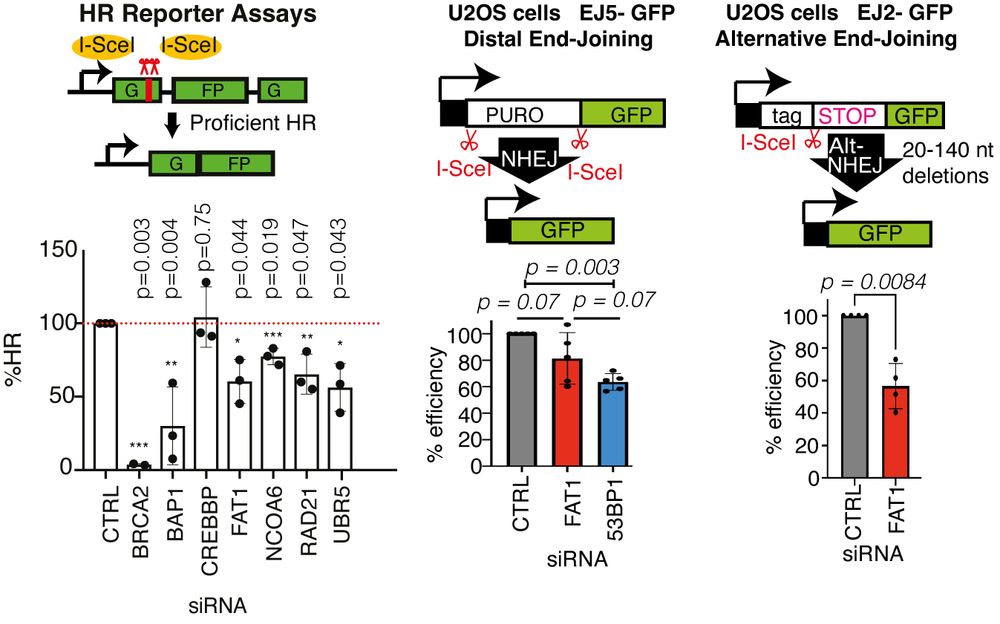
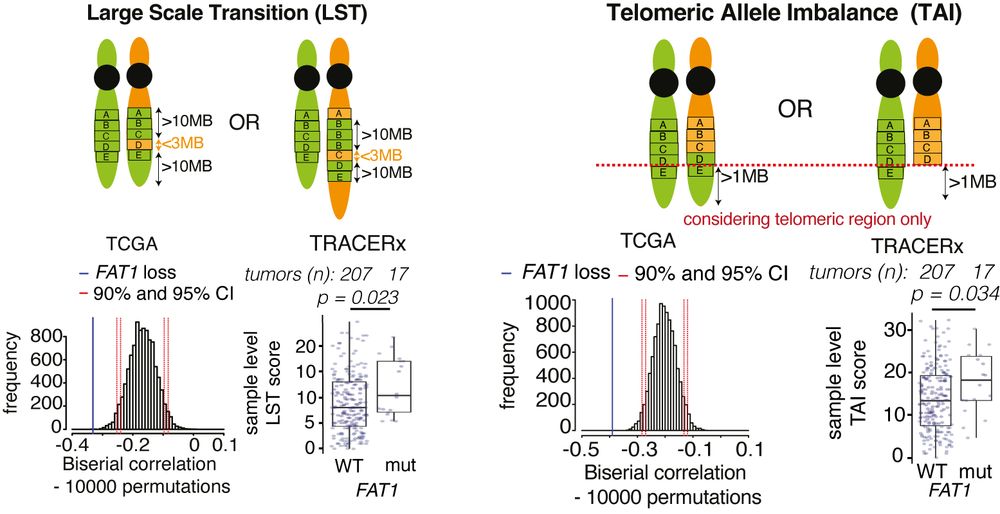
Experimentally, FAT1 depletion reduced ⏬end-resection at DNA double-strand breaks, ⏬HR repair and alternative end-joining, but did not affect cNHEJ. Using TCGA and TRACERx data, we confirmed that FAT1mutant tumours exhibited hallmarks of HR deficiencies like TAI and LST. 4/14
03.01.2025 11:22 — 👍 1 🔁 0 💬 1 📌 0
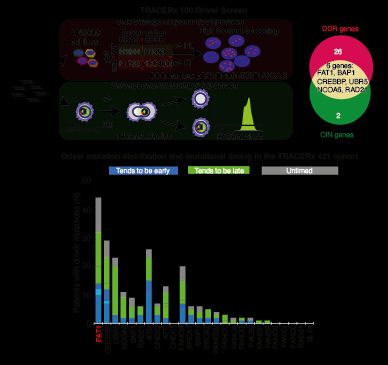
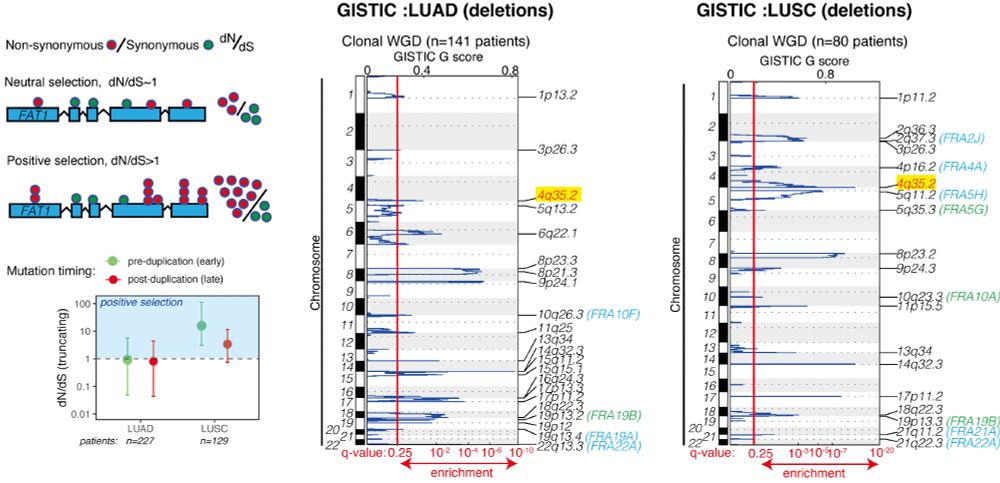
We devised 2 screens to identify drivers that might contribute to both deficiencies in the DNA damage response (DDR) and cause CIN. We focused on a gene called FAT1 (4q35.2), which is extensively mutated/lost in NSCLC before WGD, but we knew little about its function. 3/14
03.01.2025 11:22 — 👍 0 🔁 0 💬 1 📌 0
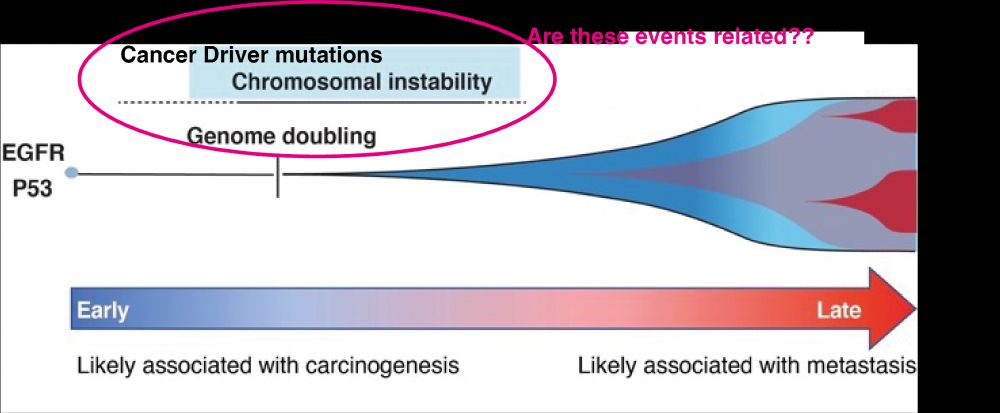
This journey started 7 years ago when we explored the cancer evolution data from TRACERx100, and observed that clonal diversification cooccurs with whole genome doubling (WGD) & extensive chromosomal instability (CIN). Might this be triggered by specific cancer driver events? 2/14
03.01.2025 11:22 — 👍 0 🔁 0 💬 1 📌 0
I am happy to see that our paper is out just before the new year!!! We have a lab tweetorial out for anyone interested! Got to say it was an exciting journey working with CharlesSwanton, the wider TRACERx and PEACE team, and @nnennayakanu.bsky.social Jiri Bartek labs. 🧵1/14
03.01.2025 11:22 — 👍 11 🔁 4 💬 1 📌 0
Congratulations Simone and team!! Great work!! 🎉🎉🎉
29.11.2024 14:10 — 👍 5 🔁 0 💬 1 📌 0
Oh no! Sorry to hear - my condolences.
19.11.2024 14:48 — 👍 1 🔁 0 💬 0 📌 0
You probably need to revive your famed cat thread here...😀
19.11.2024 14:38 — 👍 1 🔁 0 💬 1 📌 0
We use human stem cell models to understand a range of neurodegenerative disorders, with particular focus on RNA metabolism and cellular autonomy. We are based at the National University of Singapore in the LSI: https://www.nus.edu.sg/lsi/
🇺🇦 Associate professor UCONN Health. NMR, structural biology, ubiquitination, sumoylation, DUBs, sciArt
Finished a human genome, working on a few more 👨💻
Lab: https://genomeinformatics.github.io
Posts are my own
Burkard Lab | Holden Comprehensive Cancer Center | University of Iowa
Studying chromosomal instability, mitotic regulation & cancer evolution
Directed by Dr. Mark E. Burkard
MSc Biotechnology graduate | Passionate about research, innovation, and advancing life sciences | Interested in translational research & emerging biotechnologies
Group leader @gustaveroussy.fr. Computational Oncology 💻 | Cancer genomics 🧬 | Clonal Hematopoiesis and Leukemia🩸
MD, MSc | PhD Candidate at the Netherlands Cancer Institute
precision oncology | (immuno)therapy resistance | obesity
Medical Oncologist | GI & HPB tumours | Clinical Trials | Translational research
🇮🇹 @HumanitasMilano 🇪🇺 @EORTC
Postdoc at @humantechnopole.bsky.social working with Andrea Sottoriva to study the evolutionary rules of cancer.
Previously at UW Genome Sciences and @irbbarcelona.org
🔗 david.masponte.com
Group Leader
The Genome Function Laboratory
The Francis Crick Institute, London
Scientist, parent, twitter refugee, truth enthusiast, meme dealer, reluctant political junkie, occasional doom scroll interrupter ( #DDSI )
"The only shared reality is the fact-based reality."
- (paraphrased after Maria Ressa, Nobel winner)
Scientist, part-time music critic, semi-retired violinist.
PGY4 RadOnc resident at @MDAndersonNews 🩺 | @UFMDPhD '21 | Translational research | Cancer Immunotherapy | RNA vaccines | views are my own
Cancer Research | Metastasis Biology | Cellular Metabolism
Associate Prof - University of Oxford | Neuroimmunologist interested in stroke, brain injury, brain metabolism, extracellular vesicles | Dogs | Gardening | Food | Travel
M.D. - Medical Oncology Resident at the University Hospital of Pisa (Italy), focused on clinical and translational research on gastrointestinal cancers
Epigenetic reprogramming, single-cell, gene regulation, cancer biologist. Group Leader at @oncology.ox.ac.uk. Mom of 2.
https://www.oncology.ox.ac.uk/research/research-groups/orlando-group
Group Leader of Cancer Immunology
University of Oxford
Postdoc in the Boulton Lab at the Francis Crick Institute. Currently working on dna damage.




